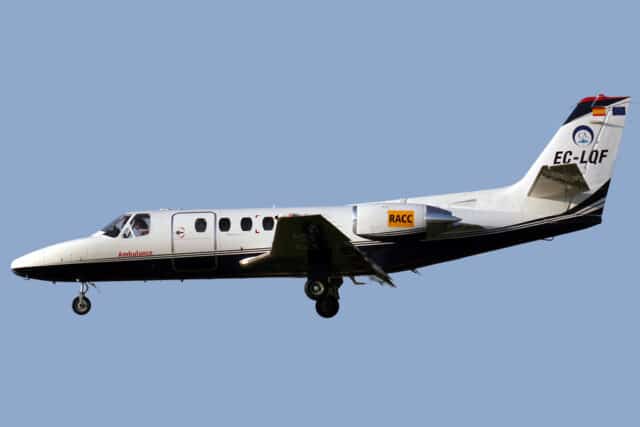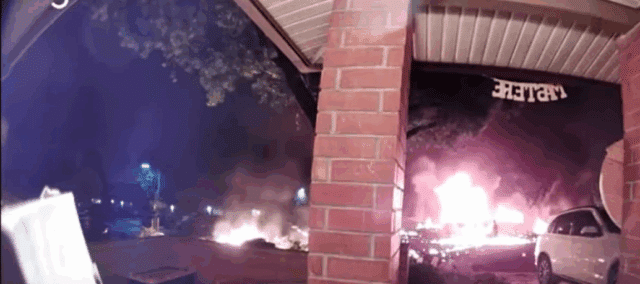Yesterday, the 22nd of May 2025, a Cessna S550 Citation II crashed in San Diego, on approach to the Montgomery-Gibbs Executive Airport.
Some of the media have reported that a “small plane” crashed, so to be clear: this was a business jet about the size of a large lorry, not a single-engine Cessna 172. The Cessna 550 Citation II is a popular mid-sized twin-engine jet, about 48 feet (14.5 metres) long and a wingspan of 52 feet (16 metres), which typically seats two flight crew and six to eight passengers.

This specific forty-year-old Citation was built in 1985 and moved around quite a bit. It was originally registered in the US as N52FT and then N550F, spent time in Canada as C-GERL, then returned to the US briefly as N1271B before becoming N666DS.
The jet initially flew from Teterboro Airport in New Jersey to Wichita, Kansas. After about a 45-minute stop, the Citation departed Wichita for a flight to San Diego with six onboard. It was scheduled to land in San Diego at 03:45 local time.
The Cessna 550 Citation II usually requires two flight crew, although it can be legally flown by a single pilot if that pilot holds a special FAA exemption with specific training and experience requirements. The jet’s owner (also the owner of a flight school) was an experienced pilot and flight instructor and has been confirmed as the pilot of the flight. He may have been certified to fly the Citation under single-pilot operations.
Shortly before the crash, a passenger posted a photograph of himself in the right seat on Instagram. The aircraft controls and windshield are visible, with a caption of “Hey. Hey…you…look at me…I’m the (co) pilot now.” His family has stated that he does not hold a pilot’s license.

However, as the situation with the flight crew has not yet been confirmed by the NTSB, I’ll refer to “crew” below, which can mean either one or two pilots.
They approached San Diego in the early hours of Thursday morning. The approach to Runway 28R has a minimum descent altitude of 673 feet above mean sea level, which is 250 feet above ground level. The minimum visibility required is 3/4 miles (1.2 kilometres).
Weather conditions were poor, with low cloud and fog. Montgomery Field’s control tower is not staffed overnight and the Automated Surface Observing System at Montgomery Field wasn’t working, which meant the crew could not get current weather conditions for their destination. They asked for weather reports at surrounding airports. The closest stations warned of half-mile visibility, below the minimum for Montgomery Field, and 200-foot ceilings.
KNKX (8 km northwest): Half-mile visibility with vertical visibility of 200 feet: essentially zero ceiling with fog sitting right on the ground.
KSEE (13 km northeast): Half-mile visibility with fog and overcast at 200 feet: same conditions.
KSAN (11 km southwest): Nine miles visibility with overcast at 1,000 feet: significantly better conditions at the main San Diego airport.
The crew considered diverting to Brown Field Municipal Airport (KDSM) but then decided against it as Brown, nestled into high terrain, has higher minimum weather requirements than Montgomery. As the conditions were only slightly better, they probably still wouldn’t be able to land.
“All right, that doesn’t sound great, but we’ll give it a go,” was the response to ATC as the pilot clearly decided to continue, hoping that the conditions at Montgomery might just be good enough to get in.
They received clearance for Montgomery’s RNAV 28R approach: a GPS-based precision approach with specific waypoints and altitudes which step the aircraft down to the runway. Initially, the Citation followed the published approach, passing waypoint NESTY at 3,600 feet and descending to 2,500 feet by waypoint PENYY. However, after the PENYY waypoint, ADS-B data shows that the Citation dropped below the prescribed glidepath.
There were no further calls on the radio.
The approach plate for Montgomery Field shows an obstruction on the approach, high tension power lines at 554 feet. If the crew had followed the approach step downs, they would have passed over the powerlines. Instead, they flew straight into them, confirmed by Citation fragments found on the ground underneath the cables.
The crew lost control of the Citation and crashed just before 4am local time, clipping a house in Tierrasanta before leaving a path of wreckage through Murphy Canyon, the US military’s largest housing neighbourhood.
The crash was not survivable. Although it has not yet been officially confirmed, all six on board are presumed dead. Amazingly, so far there are no reports of fatalities on the ground, although eight were taken to hospital.
Over a hundred firefighters and hazmat specialists responded to the scene.

A fire official on the scene told local media that there was dense fog at the accident site when they arrived. Over ten homes were damaged in the debris field which stretched for over a thousand feet, including one that was completely destroyed. Jet fuel poured down the street with cars bursting into flames on both sides of the road. The San Diego police chief sounded stunned when he described the horrific scene to the press, saying “everything [was] on fire all at once”. The Assistant Fire Chief just said, “There’s plane everywhere”.
Around a hundred residents were evacuated.
The NTSB is currently still searching for the cockpit voice recorder. I would expect a further briefing in the upcoming days, with a preliminary report expected within 30 days.


